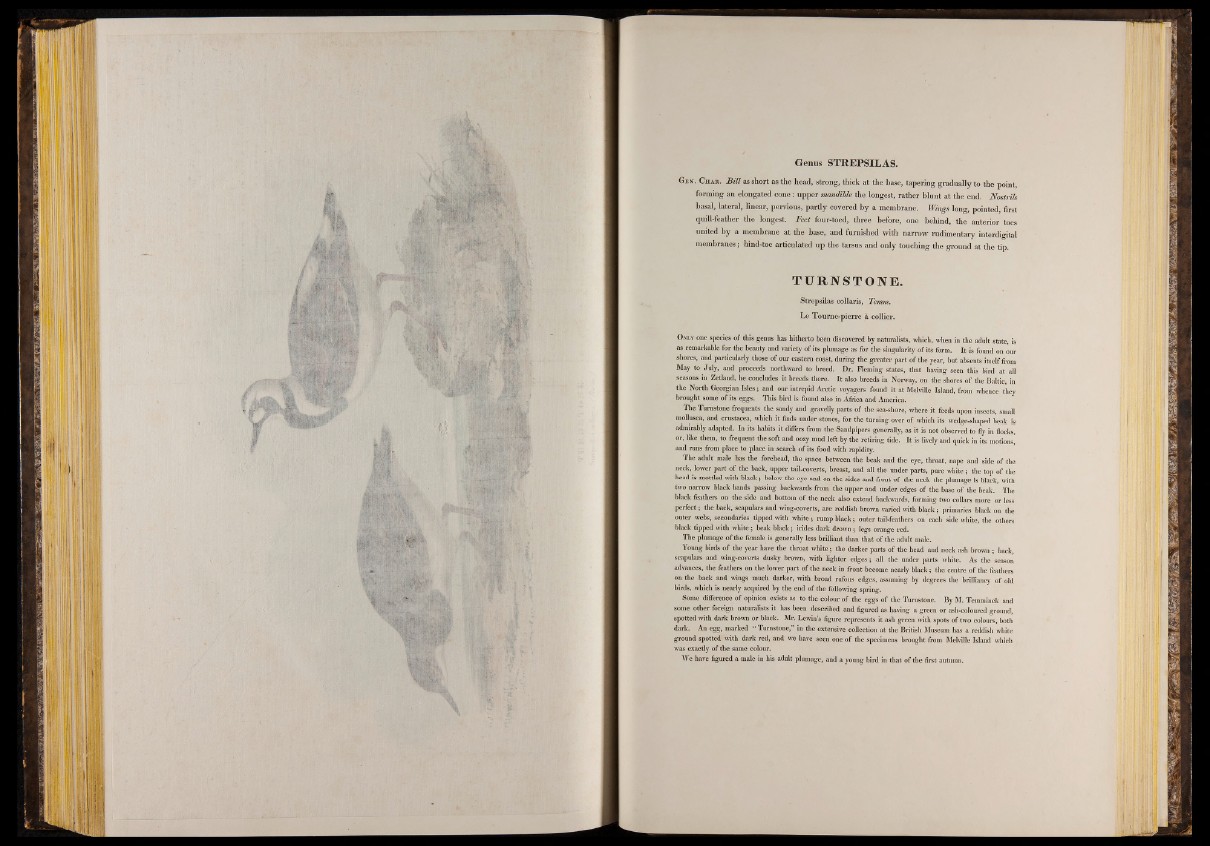
Genus STREPSILAS.
Gen. Chae. B ill as short as the head, strong, thick at the hase, tapering gradually to the point,
forming an elongated cone: upper mandible the longest, rather blunt at the end. Nostrils
basal, lateral, linear, pervious, partly covered by a membrane. Wings long, pointed, first
quill-feather the longest. Feet four-toed, three before, one behind, the anterior toes
united by a membrane at the base, and furnished with narrow rudimentary interdigital
membranes; hind-toe articulated up the tarsus and only touching the ground at the tip.
TURNSTONE.
Strepsilas collaris, Temm.
Le Tourne-pierre a collier.
O n l y one species o f this genus has hitherto been discovered by naturalists, which, when in the adult state, is
as remarkable for the beauty and variety o f its plumage as for the singularity o f its form. It is found on our
shores, and particularly those o f our eastern coast, during the greater part o f the year, but absents itself from
May to July, and proceeds northward to breed. Dr. Fleming states, that having seen this bird at all
seasons iu Zetland, he concludes it breeds there. It also breeds in Norway, op the shores o f the Baltic, in
the North Georgian Isles; and our intrepid Arctic voyagers found it at Melville Island, from whence they
brought some o f its eggs. This bird is found also in Africa and America.
The Turnstone frequents the sandy and gravelly parts o f the searshore, where it feeds upon insects, small
mollusca, and Crustacea, which it finds under stones, for the turning over o f which its wedge-shaped beak is
admirably adapted. In its habits it differs from the Sandpipers generally, as it is not observed to fly in flocks,
or, like them, to frequent the soft and oozy mud left by the retiring tide. It is lively and quick in its motions!
and runs from place to place in search o f its food with rapidity.
The adult male has the forehead, the space between the beak and the eye, throat, nape and side o f the
neck, lower part o f the back, upper tail-coverts, breast, and all the under parts, pure white; the top o f the
head is mottled with black; below the eye and on the sides and front o f the neck the plumage is black, with
two narrow black bands passing backwards from the upper and under edges o f the base o f the beak. The
black feathers on the side and bottom o f the neck also extend backwards, forming two collars more or less
perfect; the back, scapulars and wing-coverts, are reddish brown varied with black; primaries black on the
outer webs, secondaries tipped with white ; rump black; outer tail-feathers | on each side white, the others
black tipped with white; beak black; irides dark drown; legs orange red.
The plumage o f the female is generally less brilliant than that o f the adult male.
Young birds o f the year have the throat white; the darker parts o f the head and neck ash brown ; back,
scapulars and wing-coverts dusky brown, with lighter edges; ail the under parts white. As the season
advances, the feathers on the lower part o f the neck in front become nearly black; the centre of the feathers
on the back and wings much darker, with broad rufous edges, assuming by degrees the brilliancy o f old
birds, which is nearly acquired by the end o f the following spring.
Some difference o f opinion exists as to the colour o f the eggs o f the Turnstone. By M. TemminCk and
some other foreign naturalists it has been described and figured as having a green or ash-coloured ground,
spotted with dark brown or black. Mr. Lewin’s figure represents it ash green with spots o f two colours, both
dark. An egg, marked “ Turnstone,” in the extensive collection at the British Museum has a reddish white
ground spotted with dark red, and we have seen one o f the specimens brought from Melville Island which
was exactly o f the same colour.
We have figured a male in his adult plumage, and a young bird in that o f the first autumn.